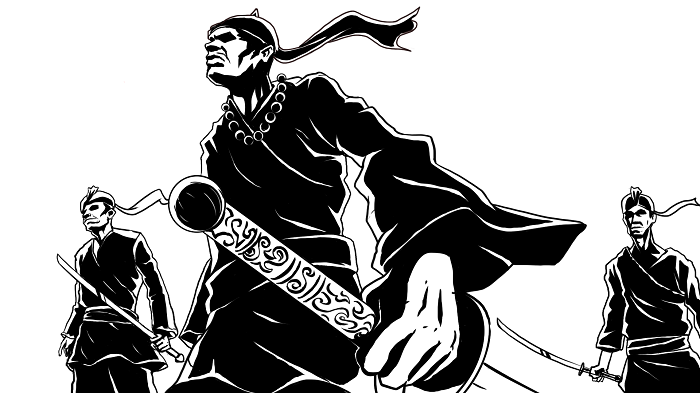India is a land of rich and diverse history and culture. So vast is its myriad cultural canvas, that the country is replete with fascinating stories hidden in the nooks and corners that has not reached many ears yet. One such a place is Assam.
Situated in the north-eastern region of India, Assam has a large number of tribal and non-tribal communities, each with distinct cultural practices of their own that adds to the rich cultural fabric of the state.
A freelance animator and visual development artist from the National Institute of Design, Ahmedabad, Amalendu Kaushik has created a short film YaYo (meaning grandmother in Majuli language) and is currently making another titled The Ahom Kingdom, both of which brilliantly depicts the unsung and almost forgotten histories of Assam. Release date of the latter has not been revealed yet.
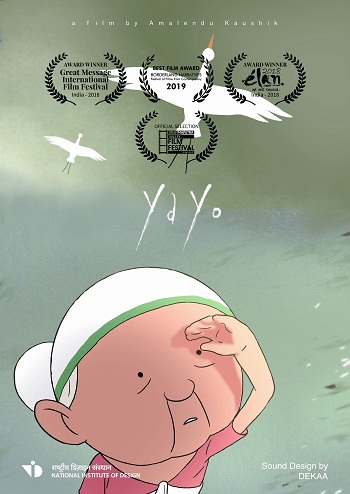 YaYo was set on the island of Majuli in a small Mishing tribal village. Majuli, located amidst the Brahmaputra River is the largest riverine island in the world and is also considered the cultural capital of Assam. This film was entirely done by Kaushik himself as his classroom project at NID and it took him eight months to finish it from ideation to execution. The sound design and score of the film was done by his friend Arunav Deka.
YaYo was set on the island of Majuli in a small Mishing tribal village. Majuli, located amidst the Brahmaputra River is the largest riverine island in the world and is also considered the cultural capital of Assam. This film was entirely done by Kaushik himself as his classroom project at NID and it took him eight months to finish it from ideation to execution. The sound design and score of the film was done by his friend Arunav Deka.
YaYo won a variety of awards including, Elan 2018 by Xavier’s college, Kolkata; nominated among the top 15 at the Brahmaputra film festival 2018 Borderland narratives 2019 initiated by RGU, Arunachal Pradesh and more.
“During our classroom project, we had extensive discussions with the department coordinator and our guides, Dhiman Sengupta and Sekhar Mukherjee. While helping me appreciate good storytelling and cinema, they also encouraged us to bring local stories from our different cultural backgrounds. I deeply researched and incorporated various cultural practices like the ‘Bhaona’ (traditional Vaishnavite drama form) and the ‘Mukha’ (traditional masks) in my film. This gave me a newfound curiosity to discover more about the cultural practices of my state. It also gave me the confidence to explore my state further,” shared Kaushik in a chat.
The Ahom Kingdom on the other hand, is about the unsung glories of Assam’s history, the stories that never made it to textbooks. The Ahom Kingdom established in present-day Assam sometime in the 13th century, by the Ahoms and continued to rule the valley for 600 glorious years. They’re the descendants of the great Shan/Tai race that occupied northern and eastern hill tracts of Upper Burma and Western Yunan. King Siu-ka-pha was the first king who came to Assam and laid the foundation of the Ahom dynasty.
Kaushik informed, “The idea started out as music video concept, but later during our research we found that there is so much to say about the history. And we ought to do justice to our history, on which our concept was based on. I felt that it is my responsibility as an animation storyteller to reinterpret and retell the great history which was otherwise neglected.”
The Ahom Kingdom will also be 2D animated film like YaYo, and will be highly stylised to make it appealing to the modern audience. The film is currently at the pre-production stage – the script, storyboarding and character designs are still in progress. Kaushik along with few other in-house animators and his friend Deka, they are planning to make this film as a pitch for crowdfunding. But the team is planning to collaborate with freelancers once the animation process starts.
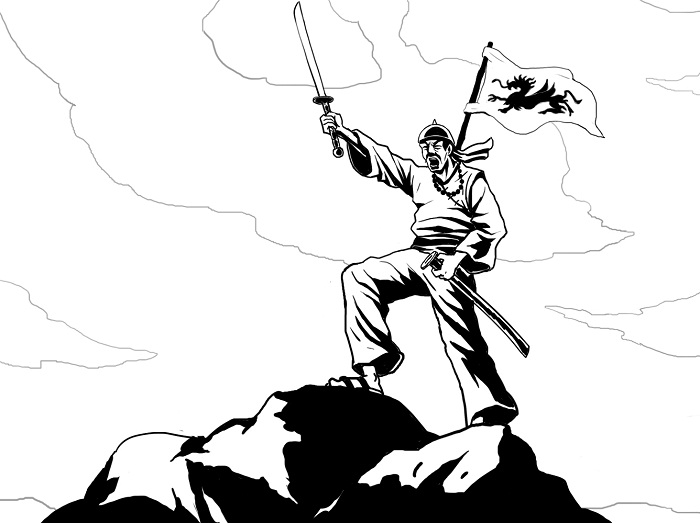
Talking about the animation process of The Ahom Kingdom , Kaushik described in detail, “It’s a blend of both traditional frame by frame animation with After Effects and CG animation. For the character animation, a pose-to-pose approach was used. Keyframes were determined for each action that needed to be animated and the in-betweens were filled in later once the key-frame animation was line-tested and tied down. While most of the character animation was pose-to-pose, there were places where straight ahead animation was also used. The background elements involved a fair amount of straight ahead animation. To understand some character movements, they need to be enacted by the animator several times. This is a popularly used method by many animators. As most of my production, I relied mostly on enacting the actions myself.”
Kaushik also emphasised on the advantages of animating films on a digital platform, as he could directly work on the layouts made and minute changes like size and position for either an individual frame or a whole set of frames could be edited in a second. Also animating on paper comes with a long lasting task of scanning the sheets, although, it comes with a very important advantage i.e. superior control of lines. So he prefers traditional hand-drawn animation on paper gives a better result, but digital hand-drawn animation saves time.
For YaYo he mentioned, “Once the storyboard was finalised and backgrounds for the film were made with reference to them in Adobe Photoshop. Rough keyframes for the character animation were made and in between in TVPaint against the backgrounds. The rough animation frames were then exported as images and were inked and flat coloured in Photoshop. These inked and coloured frames were then imported in Adobe After Effects and were compiled against the previously drawn backgrounds and individual shots for the film were made. These shots were then compiled with slight colour grading and noise simulation and compiled as a single film.”
Such amazing projects with lesser known historical concepts is surely the outcome of tiresome and extensive research. Since he has been to Majuli several times during his field trips, doing sketches, interviews and photo documentation played an effective role during his research for YaYo, besides D.N. Tamul’s book The Blessed Island.
Kaushik added, “This film strengthened my filmmaking and production skills, as I learned to imbue the images with local flavour, which came only through exhaustive research and good aesthetic. It also helped me understand how to set realistic timelines, dividing time effectively between pre production, production and post production.”
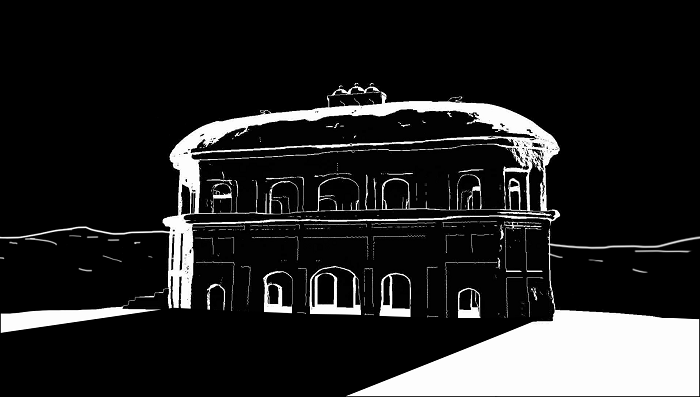
In case of The Ahom Kingdom, after finalising the time period in the story, his organised research and looking for reliable materials, directed him to noted artist and Tai-Ahom scholar and historian, Puspa Gogoi. “Gogoi has been recognised in Assam for his efforts in preserving Ahom culture and his research in Ahom history. He has been associated with several groups linked with Tai-Ahom studies like the Purbanchal Tai Sahitya Sabha and the Centre for Tai, Tribal and North East India Studies. Meeting Gogoi, proved to be a fine starting point for my in depth research work. Gogoi’s extensive study about Buranjis enlightened Kaushik with important insights into the lives and cultures of the Ahom community,” noted Kaushik.
Having said that, his path till now has obviously not been a bed of roses. Every great thing in making has to undergo several challenges, and these short films were no exception. Since YaYo was a solo project he struggled a lot to finalise the script. But conversations with his friends helped him get a better understanding and perspectives. The project also demanded a lot of patience in order to accomplish it, as a solo film includes self-criticism and discipline.
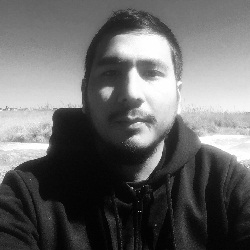
“[But] during my research in Sibsagar (town of Assam) for The Ahom Kingdom, I was extremely disappointed to see that even now most of these places were not well preserved. Most of the architecture that were in better conditions were built in the 18th century. Hence they weren’t completely reliable for my documentations. Though, I did find some materials to be inspired from, I was expecting to find a lot of material considering the fact that the Ahoms ruled the region for 600 years. But the lack in the available data that is well documented was extremely disappointing. The lack of visual data was also one of the biggest challenges that I faced in this endeavour to document the past. In addition to that, since most of the remaining artefacts are in private collections, it was impossible for me to access them. The lack of proper preservations of Ahom buildings and memorabilia was also a cause for much frustration. But with some help from documentations of other artists – painters, film makers, I have been able to create a satisfactory retelling of the events,” explained he.
The magnanimity of the project is huge and includes a big budget which quite certainly cannot be finished on their own. Thus, Kaushik and his team has decided to use trailer of The Ahom Kingdom as a pitch to convince people to contribute resources. This again is a big challenge for them, as it might or might not work out commercially or in the mainstream media.
Still working on the logistics, promotion and marketing part, they’re mostly focusing on screening The Ahom Kingdom to a wider/global audience. “We are really hopeful and pushing everyday together as a team,” he concluded.
As a wise man once said, “There’s nothing more powerful in the world than a good story. Nothing can stop it. No enemy can defeat it,” we hope to see great stories coming alive through stunning animation as the flag of Indian animation industry flies high.
